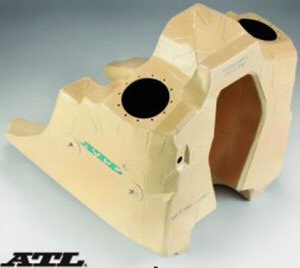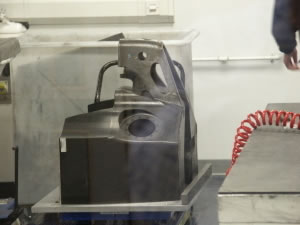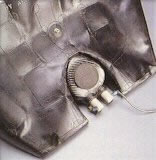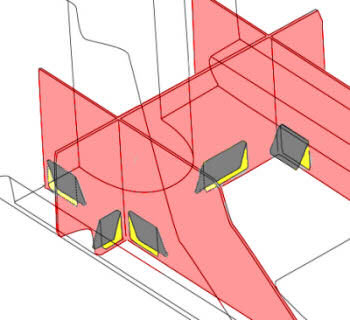Fuel cell or Fuel tank
Fuel cell is only another term for petrol tank. Historically fuel tanks were simply metal tanks formed to fit in any convenient place, prone to rupturing during accidents and impacts, the fuel could easily spill and cause a huge fire. Major fires in F1 car are now thankfully rare. It’s fair to say the biggest leap in F1 safety has probably been the advent of the flexible fuel cell when FIA, 1970 introduced Safety bladder fuel tanks. There’s been no major fuel tank fire at an F1 race since Berger Imola crash in 1989 and no fire related deaths since Ricardo Palletti in Canada in 1982, or in testing with Elio De Angelis in 1986.
 Formula 1 cars (and all other racing cars) are fitted with specially developed, flexible tanks which are practically indestructible even in the event of an accident. 1970 this type of aircraft style bag tanks were made mandatory to prevent ruptures, fuel spillage and fire in case of accidents.
Formula 1 cars (and all other racing cars) are fitted with specially developed, flexible tanks which are practically indestructible even in the event of an accident. 1970 this type of aircraft style bag tanks were made mandatory to prevent ruptures, fuel spillage and fire in case of accidents.
The fuel tanks on Formula One cars comprise a single puncture proof bladder made of military-grade ballistic material Kevlar, reinforced with rubber . These must be made of materials approved by the FIA (FT5 fuel tanks standard) and must be manufactured by certain FIA approved companies.
From FIA tech. regs.:
Minimum FIA Requirements for fuel cell FT5-1999From 1/1/99:
Tensile Strength 2000 lb (8.90 KN)
Tear Strength 350 lb (1.56 KN)
Puncture Strength 400 lb (1.78 KN)
Seam Strength 2000 lb (8.90 KN)

The size of a fuel tank is also important to be considered during chassis design. The size of the tank must be calculated against fuel consumption, expected average stint or race length, aerodynamics, etc. Since the tank is located behind the driver's seat, it largely determines the space in between the driver and the engine. The further the sidepods and the driver can be moved back, the cleaner the air will be onto the sidepods. It is therefore clear that for aerodynamic purposes, a tank should be made as small as possible. The same statement also clarifies the importance of fuel economy besides the shorter pitstops, when there is one. From 2010, formula 1 regulation prohibit refueling. Cars have to start race with full fuel load, +/-160 liters.
The tank must be situated directly behind the driver and directly ahead of the engine. All fuel lines must be equipped with selfseal breakaway (dry-break couplings) fuel couplings (introduced in FIA rule book 1970) in case if the engine and chassis become separated in an accident so fuel cannot leak from the broken hose. No fuel lines can pass through the cockpit. Fuel cell cannot extend more than 400mm from the cars centerline, so tanks are limited to being 800mm wide. Additionally teams want the fuel as close to the ground as possible so the shape of the monocoque will be modified to achieve the design capacity inside the length and width demands. Teams need to consider the packaging for the engine oil tank in the back of the monocoque, the Accident Data Recorder mounted towards the front of the tank area and the KERS batteries commonly mounted under the fuel tank area.
Fuel temperature is also a great concern. Fuel is heated by conduction and radiation from the rest of the car - the exhausts, the engine, hot lub oil lines etc. Higher fuel temperature reduces engine performance and it also makes the fuel more difficult to pump by the lift pumps. There have been developments to overcome these challenges, including changes in car design to reduce heat transfer to the fuel.
The fuel tank must be encased within a crushable structure that forms part of the car's safety cell. This structure must be able to withstand very high impact loads as specified in the regulations. Specific crash test is performed on bottom side of fuel cell.
Before 2010, for refueling during a race, teams used identical rigs supplied by one FIA-approved manufacturer. During refueling period, for safety reasons the refueling rate was limited to 12.1 liters per second. Now days, without refueling, tank capacity is 160 + liters of fuel.
The outer skin is relatively simple. Delicate stuff are hidden inside this skin. There are two systems that need to be packaged; the baffles and the fuel pump system.
As well as controlling fuel slosh and containing the fuel pumps, there is also the consideration for internal venting, so that the fuel fills and drains the tank without causing pressure variations.

 |
One way trap-doors allow the fuel to move from one compartment to the next but not back. You can see simplified arangement of the trap doors inside the bladder on picture above. |
During the race fuel tend to move around in all directions, from the forces created by moving car and high g-forces. Fuel "slosh" as it’s known, creates two problems. Firstly the weight of the fuel will alter the balance of the car and secondly the fuel needs to be drained on the fuel pump area to ensure fuel is constantly delivered to the engine. So the teams design baffle systems within the tank, to damp out of the movement of the fuel and direct it towards the last compartment where fuel pumps are located. Baffles are fitted in vertical, lateral and horizontal planes. Vertical baffles are controlling fuel slosh on turns, lateral baffles to control movement under acceleration or braking, and horizontal baffles to stop fuel rising upwards during vertical g-forces. Baffles will also direct fuel into one compartment to be collected by the fuel pump system. They will feature precision engineered one way trap-doors to allow the fuel to move from one compartment to the next but not back. Fuel will flow down the horizontal and vertical baffles towards the rear of the tank. In this final, collecting compartment, the fuel system will pick up almost all of the fuel remaining in the tank at the end of the race. Inside this last compartment three or four lifter fuel pumps will pick up the fuel and send it to a carbon fibre fuel collector tank at pressure of about 1bar. Fuel collector tank is fitted inside the cell itself and holds around 2.5 kg or 3 l litre of fuel, and it contains enough fuel to feed the main pump continuously even if supply from the lift pumps becomes intermittent at low fuel levels, particularly bearing in mind that an engine running at full revs will need up to 3.5 litres/minute of fuel. That’s enough fuel to feed the engine for 30 - 40 second or more. From collector tank, fuel will be picked up by precision high pressure main fuel pump and deliver it to car engine fuel system at pressure of max. 100bar. Entirely mechanically driven fuel pump delivers fuel to the injectors and must be protected by a fine filter at the entry. This pump delivers fuel flow fundamentally proportional to engine RPM. The fuel consumed by the engine is also approximately proportional to RPM at full throttle, but at closed throttle, the engine uses no fuel. To match the fuel supplied to the fuel required, the main pump has a variable displacement mechanism actuated by a sophisticated pressure regulating device.
 |
Courtesy of Sauber F1 team, published on their own Google+ stream: |
After passing through the pump and a final filter in the fuel rail, the fuel is delivered to the injectors at high pressure. Technical regulations forbid a pressure higher than 100 bar.
The injectors are precision electro-mechanical solenoid valves controlled by the SECU (Standard Electronic Control Unit). Fuel is delivered when the solenoid is energized, delivering it at high pressure into the intake air at precisely the right instant in the engine cycle to achieve optimum cylinder filling and mixture preparation. At 18,000rpm - before the limiter kicks in - the fuel injector is fired once every 6.6ms for a duration of 2.7ms at full throttle. The fuel delivered by each injection event is 0.049cc. However, the fuel used by the engine at full throttle in the same conditions is between 3.5 l/min and 4 l/min depending on ambient conditions.
ATL (Aero Tec Laboratories) is only FIA approved Kevlar reinforced fuel cell manufacturer, and all F1 teams using products from this manufacturer. ATL's Racing Fuel Cell Division was founded over 30 years ago. Today, ATL's advanced coated fabrics are considered state-of-the-art equipment and are used by every Formula One team and most other top racing teams across the World.
Back to the top of the page







